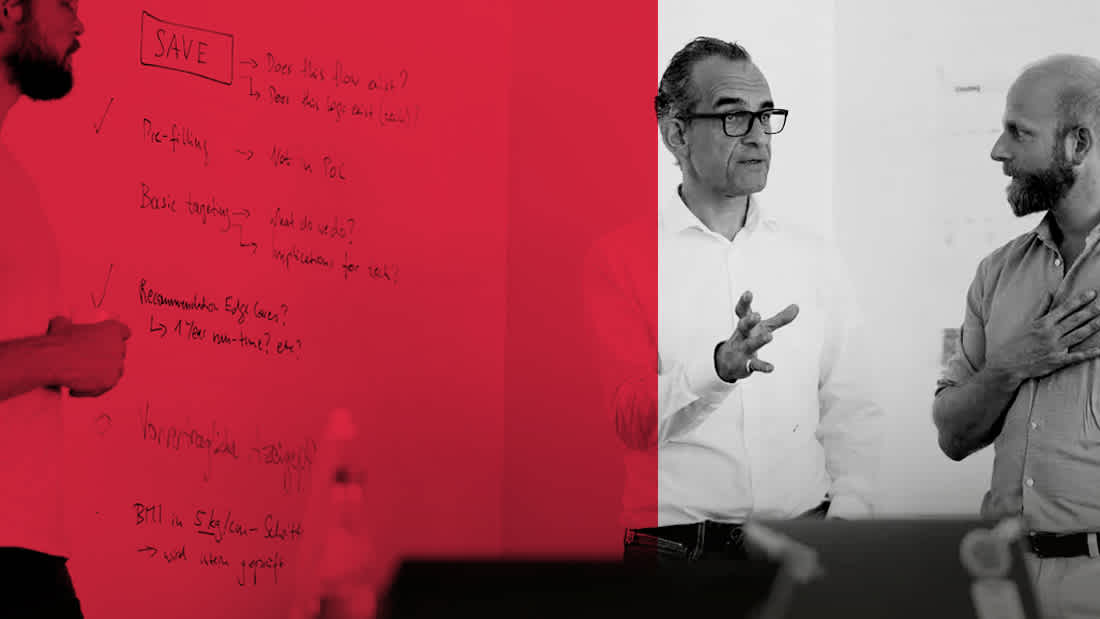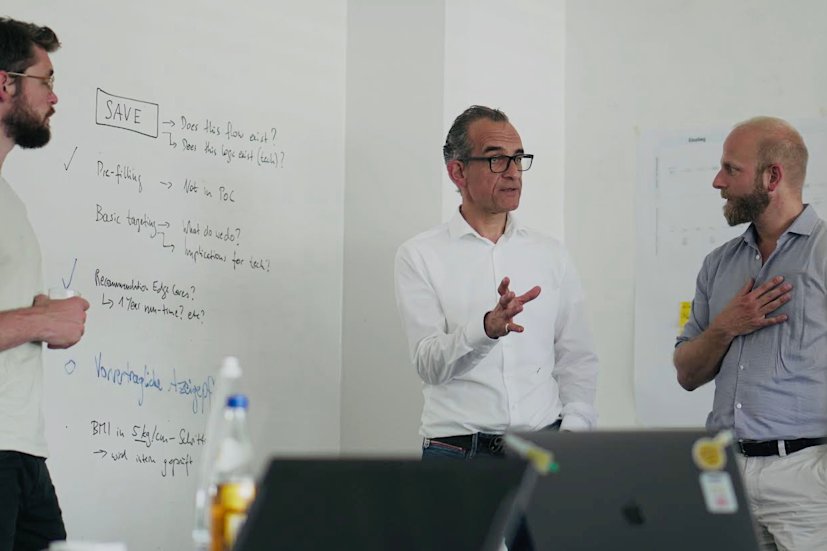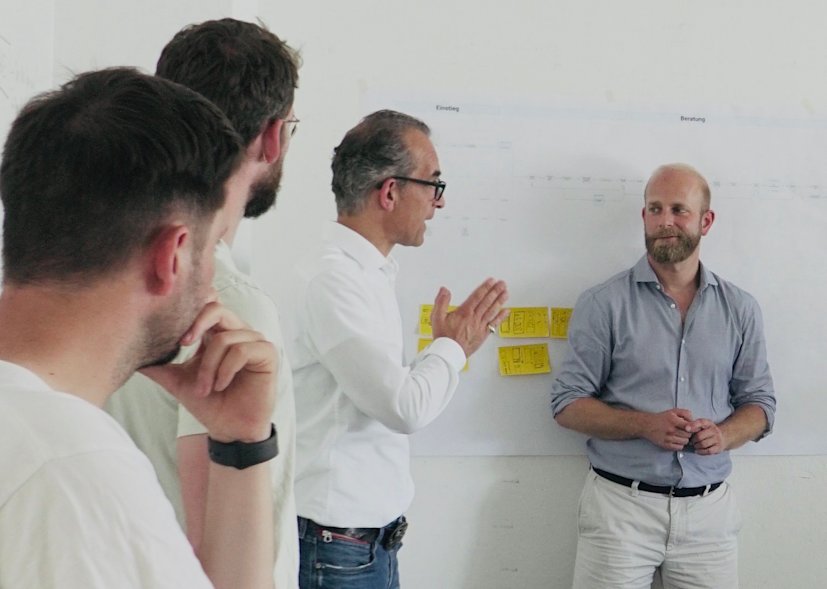Interviews
Rethinking Insurance with HUK24

Edenspiekermann was chosen as the lead partner to design the new website of HUK24 – Germany’s largest vendor of online car insurance, which boasts more than 2 million customers. Our main goal was to create a new visual identity, bring the website’s user experience to a new level and boost innovative thinking in joint teams in Coburg and Berlin.
For HUK24 and parent company HUK-COBURG this effort is mission-critical as they respond to an upheaval shaking the industry: the rise of InsurTech companies like Friday and Lemonade have transformed the sector, while giants like Amazon & Co are looking to break into the business themselves. In times like these a superior UX can make the difference when it comes to brand perception and finally conversion rates.
Why?
Read the exclusive interview with our Partner Michael Wiesemann and HUK24 Marketing Director Dr. Uwe Stuhldreier below – originally published in Werben & Verkaufen, Germany’s leading marketing and media outlet.
Text: W&V – Published: 31st of July 2019

Relaunch of HUK24:
The “hard way” to agility and user centricity
Germany’s largest direct car insurer HUK24 has completely revised its online offer, accompanied by the Berlin agency Edenspiekermann. What lies behind the UX mantra “simplicity” — and how the market leader wants to keep attacking InsurTechs at bay.
Since its founding in 2001, the HUK-Coburg subsidiary has been one of the online pioneers with more than two million customers. Since then, the face of the industry has changed significantly: More and more people take out their insurances online — fresh digital competitors like Lemonade or Friday are targeting the German market and Amazon & Co are in the starting blocks. Even established online players such as HUK24 must therefore constantly renew themselves, and the provider has just put its website on a new foundation — visually and in terms of content and technology. We spoke with Marketing Director Dr. Uwe Stuhldreier and Michael Wiesemann, Partner and Director Strategy at Edenspiekermann.
Dr. Stuhldreier, when you look at the digital shift in the insurance industry: Is there a Perfect Storm coming or is it rather a mild breeze?
Dr. Uwe Stuhldreier: With the digitalization, a large number of new providers have emerged. Startups are looking for their unique selling proposition, established insurers are experimenting with their digital ventures and new online intermediaries are fighting for market shares. But it won’t be a storm until Amazon & Co. or Chinese insurance giants like Ping An enter the German insurance market with their data-centered ecosystems. That’s why we as today’s online market leader have to position and prepare ourselves strongly towards the future with HUK24.
How do you evaluate the situation from the user's point of view?
Michael Wiesemann: Their requirements are increasing: More and more people are buying with one click at Amazon, keeping their account on N26 and data on Tinder. When we talk to users — and we do that every day in product development — we get to hear more and more: I expect my bank and my insurance company are working as easy on my phone as shopping or listening to music does.
How does HUK24's new online offering meet these needs?
Stuhldreier: None of our competitors will make it easier or cheaper to insure themselves digitally in the future. We have to admit: We are far from perfect at the moment.
Can you make this claim more concrete?
Stuhldreier: Many people have reservations: Insurance is difficult to understand; it is often not understood exactly what insurance is necessary for and what it covers. We want to create transparency for our customers. In the end, a feeling of well-being must be created, and with a clear price advantage over direct insurance.
Wiesemann: From our point of view, product benefits and a good price will no longer be sufficient as a unique selling proposition in the future. In the digital arena, it is the player who offers the best user experience and usability that wins.
A mantra like "simplicity", how does that translate into the user experience?
Wiesemann: For example, we send only one important message at a time, asking the user to make only one decision. Sounds banal, but is a challenge in a complex tariff calculator with many data points to capture. And just as critical for success when we look at conversion.

I'll claim: a startup can easily imitate that.
Stuhldreier: Theoretically, yes. But don't underestimate the role we play in the lives of people with the HUK brand as the market leader for car insurance: That gives security and trust. In concrete terms, all channels of HUK-Coburg claims management are available to HUK24 customers in the event of a claim. The new market participants first have to prove that they can settle claims on a large scale.
Wiesemann: A good example from the point of view of brand management, by the way, of how a traditional player combines the best of both worlds and thus gains a real competitive advantage. The art then lies in translating this into matching UX patterns and voice and tone.
Meanwhile, InsurTech is taking advantage of data-driven personalization. Can you keep up?
Stuhldreier: We see ourselves as digital insurance assistants. Our goal is a data-based control of the entire customer journey, for which we have built the technological platform. In concrete terms: Input fields, for example, are intelligently preassigned, the website dynamically adapts to the respective user needs.
Wiesemann: The challenge here is that the sharpened brand experience manifests itself at every point of contact with the user.
Seamless brand experience across all touchpoints: Sounds like a cliché.
Wiesemann: That sounds like it, yeah. But let's be honest: Who succeeds in a seamless brand experience today? So that it doesn't remain a catchword, it's a tough challenge. The translation of the brand promise into user-centered design principles is part of it, from which we created the new visual concept. From typography and icons to visual language. Then we translated it into individual components that live in a flexible design system.
How does the cooperation between the design agency and the client succeed in such a highly complex project?
Stuhldreier: One experience is that agencies often have a break between strategy and creation and, as service providers, work through the requirements of their clients. In Edenspiekermann, however, we wanted a broadly based partner, and I mean partner literally: because the claim is that the agency challenges us in the area of UX, questions established issues and forces us to simplify, with a high strategic understanding.
How does this manifest itself in terms of concrete cooperation?
Wiesemann: You can see this in the way the mixed teams work together, in Coburg or Berlin: they discuss passionately with each other, they fight at eye level for the best idea. In an agile work process on site. When the specialist know-how of the HUK teams and external expertise come together, the best possible user experience is created.
There is a lot of talk about agile working. Now let's be honest: How can this be implemented in a major insurance project?
Stuhldreier: Let’s not kid ourselves, our learning curve was steep at the beginning. For us as a management team, agility means that we love milestones and clearly defined final results. But an MVP (Minimal Viable Product, the editorial staff) does not have perfection as its goal, but to bring new ideas to life quickly. And to learn with it, to iterate. We have to bring this together with the basic understanding that the user does not forgive us for any gross mistakes with a product like insurance. A real challenge!
Wiesemann: What other large companies can learn from introducing agile working methods: No matter how many seminars they organize and how many stickers they distribute - in the end the right mindset of the multipliers in the company counts. That's where we work together from the first day of the project. For us today, this is an essential part of the assignment.